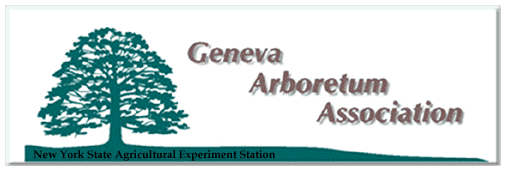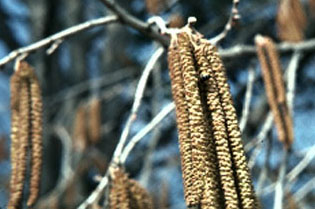

Many of us overlook the fact that all of our trees and shrubs are flowering plants. Yet, why don't we notice the millions of flowers produced each year? The answer lies in how these flowers present themselves. A great many of our common campus trees and shrubs develop small, non-showy petals or lack them altogether. They belong to the Amentiferae or catkin-bearing plants, which includes the willow, wax-myrtle, walnut, birch and oak families. Their tiny flowers are grouped together in cone-like structures known as catkins or aments. These aments are inconspicuous, so you may not have noticed their early spring efforts at flowering.
 Amentiferous
flowers are unisexual; thus a single ament is either male or female, although
both sexes occur on the same tree. Male aments are usually elongate and
drooping and develop a bright orange or yellow covering of pollen a few
weeks after they appear. A few, such as the Turkish tree hazel, will extend
their male catkins for pollen release in late winter, often by early March.
Female aments are short and few-flowered.
Amentiferous
flowers are unisexual; thus a single ament is either male or female, although
both sexes occur on the same tree. Male aments are usually elongate and
drooping and develop a bright orange or yellow covering of pollen a few
weeks after they appear. A few, such as the Turkish tree hazel, will extend
their male catkins for pollen release in late winter, often by early March.
Female aments are short and few-flowered.
The most familiar example of these "bald" members of the plant kingdom is a favorite spring messenger, the pussy willow. Species within the willow family (Salicaceae) produce their flowers in aments. Those soft silvery furry "buds" that peek out with the onset of spring are really dense clusters of minute apetalous flowers. This family also contains the poplars, aspens and cottonwood.
Some of our Station campus aments are members of the birch family (Betulaceae): birch, alder, hornbeam, ironwood and hazel. Look for paper (white) birch (IPM south lawn), European hornbeam (Rock Garden north), American hornbeam or blue beech (Barton Lab parking lot median) and Turkish tree hazel (IPM south lawn, and the softball field's "home run" tree). The hazels are the only members of this family which produce large edible nuts. Both of the Station's Turkish tree hazels are quite large, which is rare for this species. We also have two new aments, contorted specimens of the corkscrew European hazel, planted in the Hedrick-Parrott courtyard last year. The remaining members of the family bear small winged seeds often arranged loosely in clusters or "cones."
The oak family (Fagaceae) comprising the oak, beech, and chestnut genera, produce edible nuts for humans and wildlife. Our beeches are all varieties of European beech: purple-leaf beech (Parrott Hall), fern-leaf beech (Hedrick south lawn), and cut-leaf beech (Rock Garden north). There are several familiar oaks on campus, mostly centered around Jordan Hall. Also, there are a couple of hybrid chestnuts behind the pavilion.
Juglandaceae, or the walnut family, is an important wood and nut-producing family including the American and European walnut, butternut, and the hickories. Walnuts were part of a nut breeding program here at the Station. In fact, the large walnuts looming over the Pavilion's horseshoe courts are examples of such hybrids.
Our campus has only one representative of the wax-myrtle family (Myricaceae), the bayberry, tucked away at the southeast corner of the Farm Services Building. Take a look at its waxed fruit and you will see why it has been used in candle making for centuries.
How do aments attract bees and other insects for pollination without those showy petals? Most are wind pollinated. So abundant is the wind-borne pollen of many of these trees, that the pollen load often overwhelms the allergy sufferer in May. Other aments attract insects by their pendulous male catkins covered with brightly colored pollen. They may also attract potential pollinators by having nectar glands on their catkins which secrete a sweet nectar. Insects then move between the male and female aments looking for a drink and, during the course of lunch, pollinate the female flowers. So take a closer look at some of our campus aments - bald is beautiful!
by Cathy Heidenreich
Next (Living Legacies)
Return to Arboretum Home Page
Return to NYS Agricultural Experiment Station Home Page